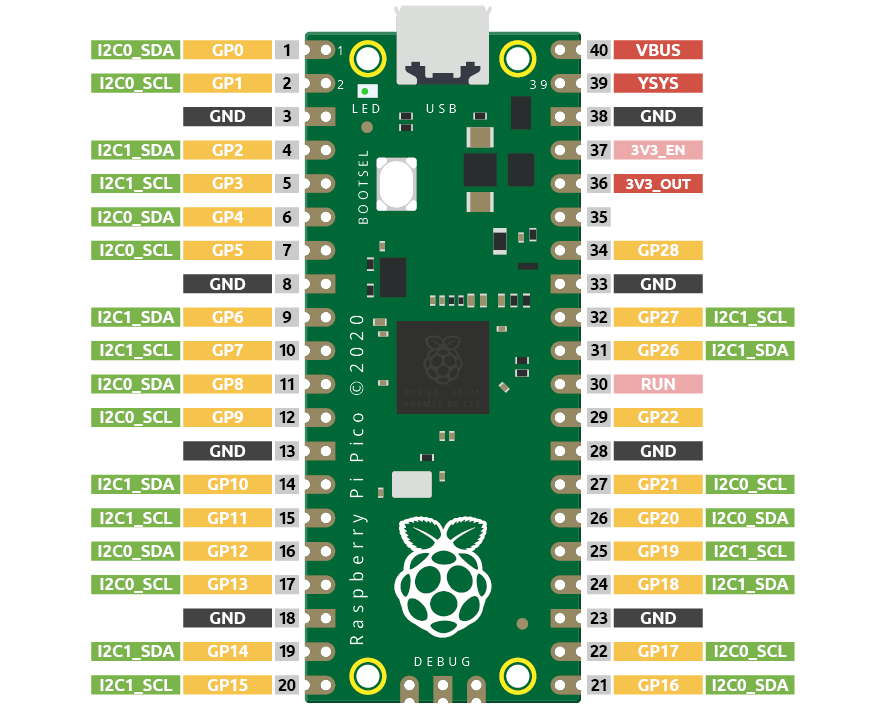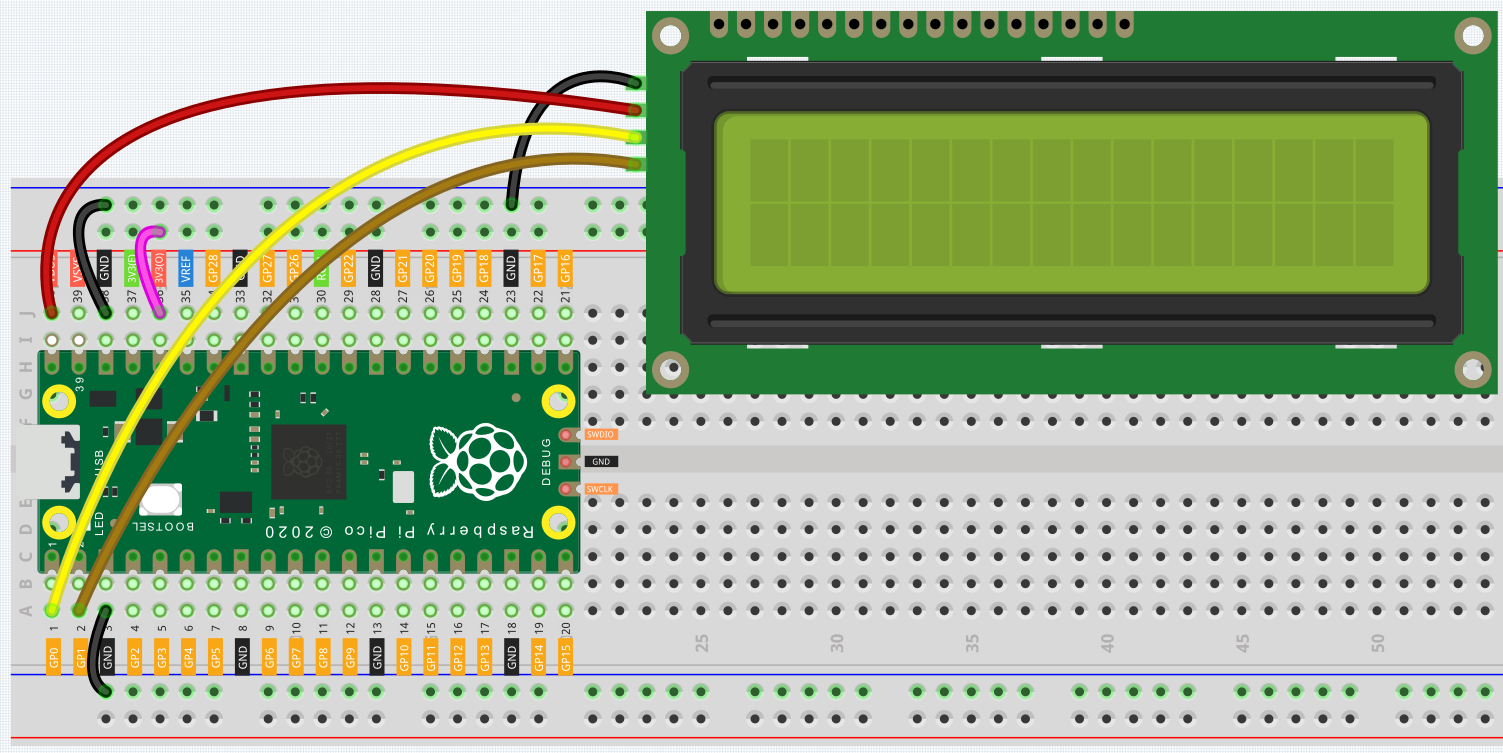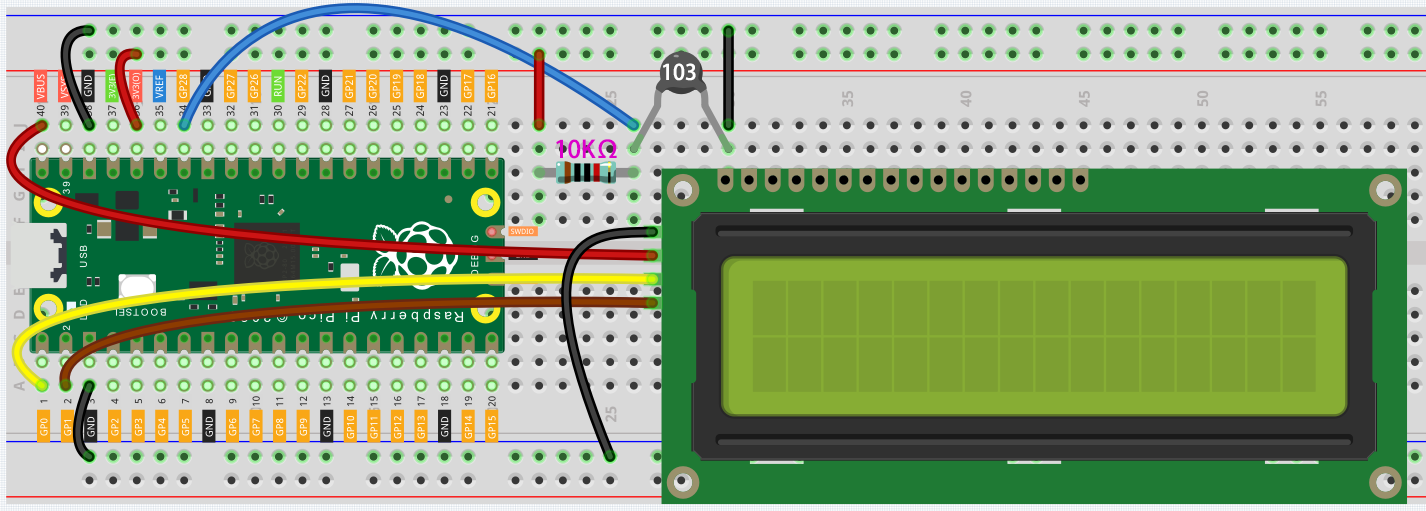2.17 Show Characters on I2 LCD1602¶
LCD1602 is a character type liquid crystal display, which can display 32 (16*2) characters at the same time.
As we all know, though LCD and some other displays greatly enrich the man-machine interaction, they share a common weakness. When they are connected to a controller, multiple IOs will be occupied of the controller which has no so many outer ports. Also it restricts other functions of the controller. Therefore, LCD1602 with an I2C bus is developed to solve the problem.
I2C(Inter-Integrated Circuit) bus is a very popular and powerful bus for communication between a master device (or master devices) and a single or multiple slave devices. I2C main controller can be used to control IO expander, various sensors, EEPROM, ADC/DAC and so on. All of these are controlled only by the two pins of host, the serial data (SDA) line and the serial clock line(SCL).
These two pins must be connected to specific pins of the microcontroller. There are two pairs of I2C communication interfaces in Pico, which are marked as I2C0 and I2C1, as shown in the figure below.

Here we will use the I2C0 interface to control the LCD1602 and display text.
Schematic¶

Wiring¶

Connect VCC of LCD to VBUS of Pico.
Connect the GND of LCD to the GND of Pico.
Connect SDA of LCD to GP0 of Pico, which is I2C0 SDA.
Connect SCL of LCD to GP1 of Pico, which is I2C0 SCL.
Create a Library¶
The following is the library of lcd1602 packaged by SunFounder.
You need to create a new file, copy the following code into it and save it to Raspberry Pi Pico under the name lcd1602.py.
You can then call it inside of other programs.
import machine
import time
class LCD():
def __init__(self, addr=0x27, blen=1):
sda = machine.Pin(0)
scl = machine.Pin(1)
self.bus = machine.I2C(0,sda=sda, scl=scl, freq=400000)
#print(self.bus.scan())
self.addr = addr
self.blen = blen
self.send_command(0x33) # Must initialize to 8-line mode at first
time.sleep(0.005)
self.send_command(0x32) # Then initialize to 4-line mode
time.sleep(0.005)
self.send_command(0x28) # 2 Lines & 5*7 dots
time.sleep(0.005)
self.send_command(0x0C) # Enable display without cursor
time.sleep(0.005)
self.send_command(0x01) # Clear Screen
self.bus.writeto(self.addr, bytearray([0x08]))
def write_word(self, data):
temp = data
if self.blen == 1:
temp |= 0x08
else:
temp &= 0xF7
self.bus.writeto(self.addr, bytearray([temp]))
def send_command(self, cmd):
# Send bit7-4 firstly
buf = cmd & 0xF0
buf |= 0x04 # RS = 0, RW = 0, EN = 1
self.write_word(buf)
time.sleep(0.002)
buf &= 0xFB # Make EN = 0
self.write_word(buf)
# Send bit3-0 secondly
buf = (cmd & 0x0F) << 4
buf |= 0x04 # RS = 0, RW = 0, EN = 1
self.write_word(buf)
time.sleep(0.002)
buf &= 0xFB # Make EN = 0
self.write_word(buf)
def send_data(self, data):
# Send bit7-4 firstly
buf = data & 0xF0
buf |= 0x05 # RS = 1, RW = 0, EN = 1
self.write_word(buf)
time.sleep(0.002)
buf &= 0xFB # Make EN = 0
self.write_word(buf)
# Send bit3-0 secondly
buf = (data & 0x0F) << 4
buf |= 0x05 # RS = 1, RW = 0, EN = 1
self.write_word(buf)
time.sleep(0.002)
buf &= 0xFB # Make EN = 0
self.write_word(buf)
def clear(self):
self.send_command(0x01) # Clear Screen
def openlight(self): # Enable the backlight
self.bus.writeto(self.addr,bytearray([0x08]))
# self.bus.close()
def write(self, x, y, str):
if x < 0:
x = 0
if x > 15:
x = 15
if y < 0:
y = 0
if y > 1:
y = 1
# Move cursor
addr = 0x80 + 0x40 * y + x
self.send_command(addr)
for chr in str:
self.send_data(ord(chr))
def message(self, text):
#print("message: %s"%text)
for char in text:
if char == '\n':
self.send_command(0xC0) # next line
else:
self.send_data(ord(char))
Code¶
Then, create a new file, and call the lcd1602 library stored before in this file.
from lcd1602 import LCD
import utime
lcd = LCD()
string = " Hello!\n"
lcd.message(string)
utime.sleep(2)
string = " Sunfounder!"
lcd.message(string)
utime.sleep(2)
lcd.clear()
After the program runs, you will be able to see two lines of text appear on the LCD in turn, and then disappear.
How it works?¶
In the lcd1602 library, we integrate the relevant functions of lcd1602 into the LCD class.
Import lcd1602 library
from lcd1602 import LCD
Declare an object of the LCD class and name it lcd.
lcd = LCD()
This statement will display the text on the LCD. It should be noted that the argument must be a string type. If we want to pass an integer or float, we must use the forced conversion statement str().
lcd.message(string)
If you call this statement multiple times, lcd will superimpose the texts. This requires the use of the following statement to clear the display.
lcd.clear()
What more?¶
We can combine thermistor and I2C LCD1602 to make a room temperature meter.

from lcd1602 import LCD
import machine
import utime
import math
thermistor = machine.ADC(28)
lcd = LCD()
while True:
temperature_value = thermistor.read_u16()
Vr = 3.3 * float(temperature_value) / 65535
Rt = 10000 * Vr / (3.3 - Vr)
temp = 1/(((math.log(Rt / 10000)) / 3950) + (1 / (273.15+25)))
Cel = temp - 273.15
#Fah = Cel * 1.8 + 32
#print ('Celsius: %.2f C Fahrenheit: %.2f F' % (Cel, Fah))
#utime.sleep_ms(200)
string = " Temperature is \n " + str('{:.2f}'.format(Cel))+ " C"
lcd.message(string)
utime.sleep(1)
lcd.clear()